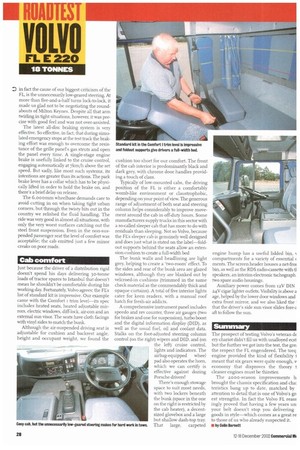RUICEST V OVO PE L YJ 18 TONNES
Page 28

If you've noticed an error in this article please click here to report it so we can fix it.
in fact the cause of our biggest criticism of the FL, is the unnecessarily low-geared steering. At more than five-and-a-half turns lock-to-lock, it made us glad not to be negotiating the roundabouts of Milton Keynes. Despite all that arm twirling in tight situations, however, it was precise with good feel and was not over-assisted.
The latest all-disc braking system is very effective. So effective, in fact, that during simulated emergency stops at the test track the braking effort was enough to overcome the resistance of the grille panel's gas struts and open the panel every time. A single-stage engine brake is usefully linked to the cruise control, engaging automatically at 7knith above the set speed. But sadly, like most such systems, its intentions are greater than its actions. The park brake lever has a collar which has to be physically lifted in order to hold the brake on, and there's a brief delay on release.
The 6,000rnm wheelbase demands care to avoid cutting in on when taking tight urban corners, but through the twisty bits out in the country we relished the fluid handling. The ride was very good in almost all situations, with only the very worst surfaces catching out the steel front suspension. Even in the non-suspended passenger seat the level of comfort was acceptable; the cab emitted just a few minor creaks on poor roads.
Cab comfort
Just because the driver of a distribution rigid doesn't spend his days delivering 30-tonne loads of tractor spares to Istanbul that doesn't mean he shouldn't be comfortable during his working day. Fortunately, Volvo agrees; the FLs list of standard kit is impressive. Our example came with the Comfort I trim level—its spec includes heated seats, heated adjustable mirrors, electric windows, diff-lock, air-con and an external sun visor. The seats have cloth facings with vinyl sides to match the bunk.
Although the air-suspended driving seat is adjustable for cushion and backrest angle, height and occupant weight, we found the cushion too short for our comfort. The front of the cab interior is predominantly black and dark grey, with chrome door handles providing a touch of class.
Typically of low-mounted cabs, the driving position of the FL is either a comfortably womb-like environment or claustrophobic, depending on your point of view. The generous range of adjustment of both seat and steering column helps considerably to improve movement around the cab in off-duty hours. Some manufacturers supply trucks in this sector with a so-called sleeper cab that has more to do with residuals than sleeping. Not so Volvo, because the FLs sleeper cab is genuinely well designed and does just what is stated on the label—foldout supports behind the seats allow an extension cushion to create a full-width bed The bunk walls and headlining are light grey, helping to create a 'two-room' effect. To the sides and rear of the bunk area are glazed windows, although they are blanked out by velcroedin cushions (trinuned in the same check material as the commendably thick and opaque curtains). A total of five interior lights cater for keen readers, with a manual roof hatch for fresh-air addicts.
A comprehensive instrument panel includes speedo and rev counter, three air gauges (two for brakes and one for suspension), turbo boost and the digital information display (DID), as well as the usual fuel, oil and coolant data. Stalks on the foot-adjusted steering column control (on the right) wipers and DID, and (on the left) cruise control, lights and indicators. The airbag-equipped wheel pad also operates the horn, which we can certify is effective against dozing Porsche drivers!
There's enough stowage space to suit most needs, with two lockers beneath the bunk (space in the one on the right is restricted by the cab heater), a decentsized glovebox and a large but shallow dash-top tray. That large, carpeted
engine hump has a useful lidded bin, N compartments for a variety of essential ments. The screen header houses a net-froi bin, as well as the RDS radio-cassette with ti speakers, an interim electronic tachograph two spare audio housings.
Auxiliary power comes from 12V DIN 24V cigar lighter outlets. Visibility is above a age, helped by the lower door windows and extra front mirror, and we also liked the that the driver's side sun visor slides fore-s aft to follow the sun.
Summary
The prospect of testing Volvo's veteran ch ery chariot didn't fill us with unalloyed ecst but the further we got into the test, the gre; the respect the FL engendered. The torq engine provided the kind of flexibility 1 meant that six gears were quite enough, v economy that disproves the theory cleaner engines must be thirstier.
The z000-season improvements h brought the chassis specification and cha: teristics bang up to date, matched by attention to detail that is one of Volvo's gr, est strengths. In fact the Volvo FL rears ingly proved that having a few years un your belt doesn't stop you delivering goods in style—which comes as a great re to those of us who already suspected it.
• by Coln Barnett




























































































































































